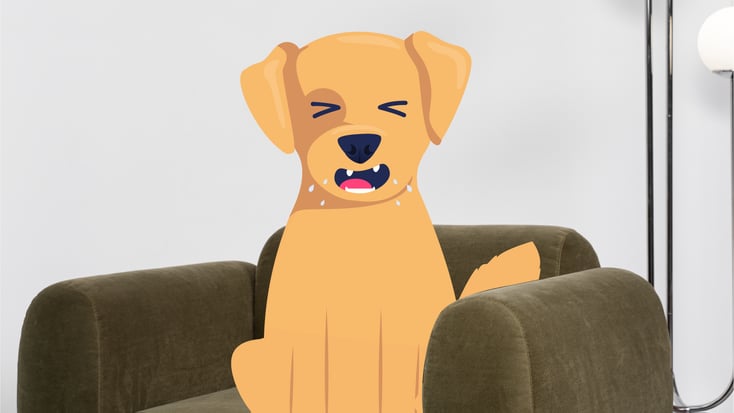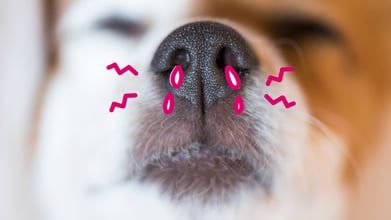Reverse Sneezing in Dogs: Causes & Treatment

Table of Contents
As a pet parent, you might have heard strange noises like your dog inhaling sneezes into its nose. These episodes can be alarming because your dog can look like it's struggling to breathe.
If you've witnessed this with your dog, the first thing to know is that this isn't coughing; it is called reverse sneezing, and it's more common than you think. Most of the time, it's completely normal, but some factors can trigger this issue in dogs. There are also ways to treat and prevent it.
So, is your dog's reverse sneezing dangerous? How can you treat and prevent it? In this comprehensive guide to reverse sneezing, we'll answer all your questions.
Key Takeaways:
- Reverse sneezing in dogs is a common and usually harmless reflex action that helps clear the nasal passages.
- It is important to differentiate between reverse sneezing and coughing, as coughing can indicate underlying health issues.
- If reverse sneezing persists or the dog shows signs of distress, it is recommended to consult with a veterinarian for proper evaluation and diagnosis.
What Is Reverse Sneezing in Dogs?
Normally, a dog pushes air out of its nose if there is an irritant, but it's the opposite in reverse sneezing. Here, the dog rapidly and intensely inhales air, which results in it producing a cough-like sound. It's important to determine whether your dog is reverse sneezing or coughing, as coughing can be a symptom of an enlarged heart or kennel cough infection.
Why Do Dogs Reverse Sneeze?
Dogs may reverse sneeze due to various reasons. Reverse sneezing is a reflex action that helps clear the nasal passages of irritants or mucus. Excitement, allergies, respiratory infections, post-nasal drip, or nasal irritants can trigger it. During a reverse sneeze, dogs rapidly inhale air, producing a snorting or honking sound.
While it may appear alarming, reverse sneezing is usually harmless and self-resolves. However, if your dog experiences frequent or prolonged episodes, it's advisable to consult with a veterinarian for a proper evaluation and to rule out any underlying respiratory issues.
Keep reading: 11 Signs Your Pet Needs to See a Vet
Causes of Reverse Sneezing in Dogs
While reverse sneezing is usually harmless and temporary, it's essential to identify its underlying causes to ensure the well-being of our furry companions. Here are some possible underlying causes:
Allergies or irritants
Most dogs reverse sneeze when the areas around the nose, back of the throat, or sinuses are irritated. Irritants include smoke, pollen, grasses, seeds, or certain odors. Dogs with seasonal allergies are more prone to sneezing.
Presence of bugs or parasites
Sometimes, the irritants in your dog's nose are alive and moving! Worms, worm larvae, and nasal mites that enter the dog's nasal cavity can cause dogs to reverse sneeze. If you have more than one dog in the house and they start to do this one after the other, parasitic infestation might be the underlying cause.
Nasal inflammation or infections
Dogs can develop rhinitis or sinusitis. When this happens, mucus may start developing, and as a natural response, dogs reverse sneeze to clear their nasal passages.
Trauma
Injuries to the nose can also cause repeated episodes of reverse sneezing. One veterinary case report describes a dog who caught a stick in its mouth while playing, and the stick pushed a hole in the dog's soft palate from the mouth to the nose. This accident caused injury to the dog's nasal lining, and the dog tended to reverse sneeze, which lasted even after the wound was healed.
Excitement or exercise
Dogs can reverse sneeze when excited or happy, often after playing or exercising. For example, dogs may do this when they welcome their family back home.
Structural abnormalities
Some breeds of dogs are more prone to reverse sneezing than others. Dogs like pugs and bulldogs are known to have elongated soft palates, which extra length can obstruct adequate airflow.
Breeds like chihuahuas are more susceptible to respiratory disorders compared to other breeds. They can be prone to tracheal collapse, where the windpipe is weak and can fold in on itself. This can then manifest as coughing or reverse sneezing.
Other conditions
Reverse sneezing can be a symptom of other problems with the respiratory tract, like polyps, nasal tumors, or other respiratory illnesses.
Symptoms of Canines Reverse Sneezing
Dog reverse sneezing can be mistaken for coughing. To help you identify it, here is a video of a classic dog episode. You can also watch out for these signs:
- Dog breathing heavily through the nose. You may notice abnormal breathing patterns in your dog. This involves deep breaths that are coming from the mouth.
- Honking or snorting noise. When dogs forcefully pull the air through their nose, you hear a loud snorting sound.
- Rapid, noisy breathing. You will notice rapid breathing patterns accompanied by noise.
- Head and neck extended forward. When reverse sneezing, dogs tend to stiffen while extending their neck and head forward.
- Eyes are bulging or watering. Excessive sneezing can make the dog's eyes bulge and water. Irritants can contribute to this symptom.
Treatment for a Reverse Sneezing Episode in Dogs
Most dogs experiencing reverse sneezing do not need medical treatment. Here are a few treatments you can do at home to make your dog feel comfortable and the options your vet might suggest if the episodes persist.
Gently massaging the dog's throat
Lightly massaging your dog's neck. This treatment can calm your pet down. Talk to your dog softly while doing the massages. This can be very effective, especially if the cause is due to excitement.
Covering the dog's nostrils
Cover your dog's nostrils for a brief moment. Holding the dog's nostrils closed briefly and gently petting its throat will help it swallow and clear its nose of any irritation, thereby stopping the spasm.
Offering water or food
Water can clear any irritants that are causing the reverse sneezing. Food also diverts the dog's focus and stops the spasm.
Using medication
Dogs can become exhausted from reverse sneezing for a long time. In that case, vets may prescribe antihistamines if they determine that the cause is an extreme allergic reaction. They may also prescribe corticosteroids to help reduce inflammation.
Surgical procedure
Surgical procedures may be needed in severe and frequent reverse sneezing episodes. Soft palate resection is done on dogs with excess tissue in the soft palate area to allow better airflow.
How to Stop Dogs From Reverse Sneezing
Reverse sneezing is generally harmless, but it can be very uncomfortable for your pet and distressing for you as a pet parent. Here are some ways to prevent dogs from reverse sneezing.
- Keep the dog's environment clean. Ensure the surroundings are clean to prevent any infestation of parasites like worms, nasal mites, and bugs. Ensure the dog is also free from fleas, ticks, and other parasites.
- Minimize exposure to irritants. Pet parents should be mindful if certain plants cause allergic reactions in their pets. Avoid using substances with a strong scent, such as cleaning products at home, particularly in the areas where your dog spends the most time.
- Avoid sudden changes in activity level. This can make dogs overexcited and can trigger a reverse sneezing episode.
- Regular checkups with a veterinarian. Frequent monitoring by a trusted vet can check if these episodes are still normal or if they are clinical signs of a more serious condition.
Conclusion
Reverse sneezing should not alarm pet parents unless it lasts for a while. Some treatments can be done at home, such as gentle neck massage, briefly covering the nostrils, and offering water. If your dog's reverse sneezing seems excessive, or if your dog seems in distress, it's crucial to get a vet assessment and make sure there are no underlying causes. With an in-home vet care service, your veterinarian can observe your dog in their normal surroundings to provide a more accurate diagnosis for your pet.
Frequently Asked Questions
What triggers reverse sneezing in dogs?
A reverse sneeze episode can be caused by allergies, irritants, parasites, bugs, inflammation, infection, trauma from injury, excitement, structural abnormalities, or in very rare cases, serious health conditions like nasal tumors.
Is reverse sneezing in dogs dangerous?
Not usually. Most dogs reverse sneeze occasionally, and it should not alarm pet parents.
How much is too much reverse sneezing?
A normal reverse sneeze episode lasts 30 seconds to one minute, and one or two occurrences in a day are normal. If you notice your dog doing it more than that, visit your vet to check if there is a more serious underlying health issue.
Should I give my dog Benadryl for reverse sneezing?
A vet may prescribe antihistamines like Benadryl, but you should not give your dog Benadryl alone. While Benadryl can stop reverse sneezing, it doesn't treat the root cause of the problem. Overdosing is also possible without a vet's supervision.





